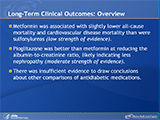- Home
- Slides
- Home
- Tools and Resources
- Research Summaries for Consumers, Clinicians, and Policymakers
- Search for Research Summaries, Reviews, and Reports
- Research Available for Comment
- Submit a Suggestion for Research
- Submit Scientific Information Packets
- Comparative Effectiveness Research Grant and ARRA Awards
- News and Announcements
- What Is Comparative Effectiveness Research
- Who Is Involved in the Effective Health Care Program
- What Is the Effective Health Care Program
Slides
Slides: 1–12 of 31
Results of Trials Evaluating the Addition of an ACEI or an ARB to Standard Therapy for Stable Ischemic Heart Disease and Preserved Left Ventricular Systolic Function
Long-Term Clinical Outcomes: Overview
Presentation: Comparing Medications for Adults With Type 2 Diabetes
Keywords: long-term clinical outcomes | mortality | morbidity | cardiovascular disease | nephropathy
Management of Chronic Kidney Disease Stages 1–3
Presentation: Management of Chronic Kidney Disease Stages 1–3
Keywords: comparative effectiveness review | screening | monitoring | treatment | chronic kidney disease
Outline of Material
Presentation: Management of Chronic Kidney Disease Stages 1–3
Keywords: comparative effectiveness review | screening | monitoring | treatment | chronic kidney disease
Background: Chronic Kidney Disease Stages
Presentation: Management of Chronic Kidney Disease Stages 1–3
Keywords: chronic kidney disease | stages | definitions
Background: Public Health Impact
Presentation: Management of Chronic Kidney Disease Stages 1–3
Keywords: chronic kidney disease | prevalence | stages | risk factors
Background: Risk Factors and Comorbidities
Presentation: Management of Chronic Kidney Disease Stages 1–3
Keywords: chronic kidney disease | prevalence | comorbidity | risk factors
Background: Associated Adverse Outcomes
Presentation: Management of Chronic Kidney Disease Stages 1–3
Keywords: adverse outcomes | chronic kidney disease
Factors That Impact Potential Benefit of Screening Adults for CKD Stages 1–3
Presentation: Management of Chronic Kidney Disease Stages 1–3
Keywords: screening | chronic kidney disease
Clinical Questions Addressed in the CER: Treatments for CKD Stages 1–3
Presentation: Management of Chronic Kidney Disease Stages 1–3
Keywords: comparative effectiveness | chronic kidney disease | treatment | adverse effects
Clinical Questions Addressed in the CER: Clinical Outcomes of Interest From Treatments
Your slide tray is being processed.


 E-mail Updates
E-mail Updates










